Discover Binh Dinh – The land of Vietnam's martial arts
Binh Dinh is also a destination where thevremains of the Ancient Champa Empire are preserved. Nowadays, the province has become an attractive destination for both Vietnamese and foreigners as most of the natural beauty in Binh Dinh such as beaches, swamplands and poplar woods are mostly untouched.
Nui Ba (Ba Mountains)
 |
Situated South of Dam Thuy Pond in Phu Cat District, Ba Mountains (also called Pho Chinh Mountains) is considered one of the most magnificent mountains in Binh Dinh province.
The Ba Mountains consists of more than 60 mounts with diverse height and shapes. It is interspersed with lush valleys and watered by numerous mountain streams. The combination of all these elements makes the place an ideal location for eco-tourism and adventure travel.
Some of the famous spots of Ba Mountains complex are Hang Rai Mount in the South East, Heo Mount in the North East and the highest one Chuong Mount (or Chung Son Mountain) with the height of 900m.
Chuong Mount has a unique round shape, which is often visualized as a giant downward bell (In Vietnamese, “Chuong” means bell).
Visitors cannot leave without seeing the Vong Phu Stones (Waiting for Husband). This natural masterpiece consists of a high stone standing side by side with a smaller one, identical to an adult next to her child.
For 100 years, local people have told their descendants about the sad legend of Vong Phu: the stones embody a young wife and her son, both of whom waited for the husband for a very long time until they all became rocks. The stones have ever since been used to symbolize Vietnamese women’s fidelity in love and family.
Ba Mountains also houses numerous historical and cultural traces from the Chiem Capital of the Cham Kingdom, to thevTay Son Revolution and was also a crucial army base of Vietnam revolutionaries against French and American colonialists.
A visit to Ba Mountain in Binh Dinh will offer tourists an enriching experience and learning opportunity about both Vietnam history and its natural wonders.
Ham Ho
 |
Ham Ho is a downstream part of the Kut River in Tay Son, Binh Dinh, and located 55km of Quy Nhon City.
The name originated from a unique phenomenon that occurs here in the dry season. In a drought year when people wanted rain, sounds of people screaming and praying at this bend of the river could be heard. The local people began to call this place Ham Ho, or ‘Yelling Cellar’.
This part of the Kut River is only 1km, but is lush green all year long with cool streaming waters. Along the river banks is a dense forest mixed with high cliffs, dotted by a number of marble outcroppings with varied strange shapes.
There are several stone places that are of particular interest to visitors, such as Chess Stone, Flying Fish Stone, and the Gates of Life and Death, known as the Giant’s Feet.
Ham Ho is also famous because it draws a considerable number of fish, especially in the flood season.
In addition, fish that come to Ham Ho always swim against the river’s flow and get pushed into the air, so this particular part of the river is called The Flying Fish.
Thi Nai Lagoon
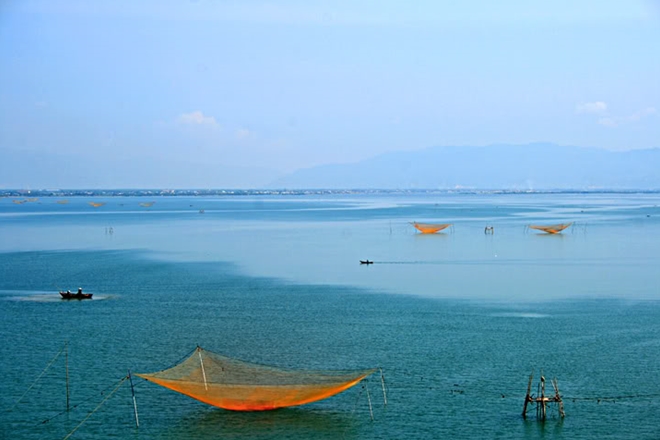 |
Situated in the northeast of Quy Nhon, Thi Nai is the largest lagoon in Binh Dinh, extending 10km in length and four kilometers in width.
It has many kinds of fish. On an islet in the middle of the lagoon is a mount that resembles a temple. Local fishermen have built a pagoda on the mount to worship the god of water.
In early mornings and late evenings the lagoon is covered with a mist that makes it resemble a fairy place.
Ky Co
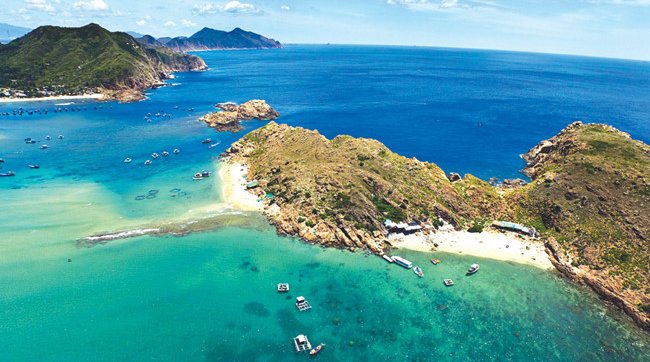 |
Ky Co Island has recently been suggested by experienced tour guides as a must-see destination for travelers who want to indulge in serenity.
The tranquil island is 25 kilometers north off Quy Nhon city, so tourists can make a one-day visit.
There is no house on Ky Co except for several thatched huts of a local company. If tourists do not bring along food, they will leave the island hungry as there is no shop or eatery on the island. Therefore, to prepare for lunch, tourists traveling to the island by boat arranged by local fishermen can ask the latter to take them to a market in Nhon Ly to buy essential items at very low prices.
Nhon Ly is home to untouched beaches with smooth sand and surrounded by high cliffs. Visitors can see schools of fish around when they swim in the crystal seawater. They can trek on the island but steep terrain may discourage many from exploring the island.
While swimming in the cool seawater, visitors will be captivated by rocks with magnificent shapes and green hills from afar. After a sea bath, they can take a bath with fresh water at bathrooms built on the island by tourist companies at a cost of VND2,000 per person.
Admiring the charm and tranquility of Ky Co, many visitors collect garbage and bring it back to mainland in an effort to keep the island clean.
Hoang De Citadel
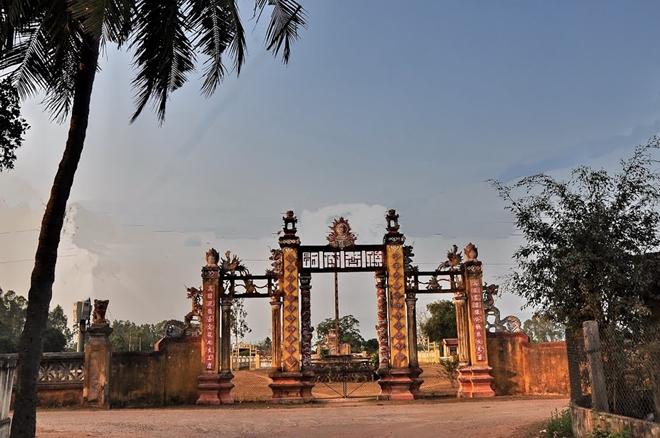 |
Hoang De citadel was the last capital of the Champa Kingdom where the Cham Kings lived between the 11th and the 15th centuries. Several pieces of stone walls, moats, and granite-tiled roads remain from the Citadel.
It is 27km northwest of Qui Nhon City in Nhon Hau Commune, An Nhon District. Characteristics: The citadel was built at the end of the 10th century, during the reign of Emperor Yangpuku Vijaaya.
Inside the Citadel, there are ancient Cham remains, such as square wells and statues of small lions and elephants. Next to the back door is Thap Thap Hill (Ten Tower Hill), on which there are ten Cham Towers. Of note is the 20m-high Canh Tien Tower with white-stone statues of a snake, two elephants, and monsters on the corners.
There are many remains and objects related to Cham culture and the Tay Son movement in Thap Thap Di Da Pagoda and Nhan Thap Pagoda, two ancient pagodas situated to the north and south of the citadel.
In 1778, Nguyen Nhac proclaimed himself the Central Emperor. He established the capital, which he named Hoang De Citadel, expanded the citadel to the east, and built many grand monuments.
In 1799, the citadel was occupied by the Nguyen Dynasty, and rebaptized Binh Dinh Citadel. In 1814, the Nguyen Dynasty destroyed the old citadel and built a new one about 5km south of the old citadel.
Nhon Ly Dunes
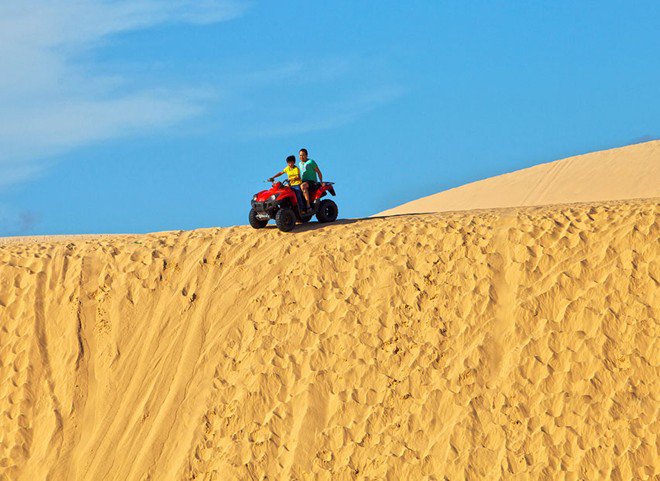 |
The Clusters of Champa Towers
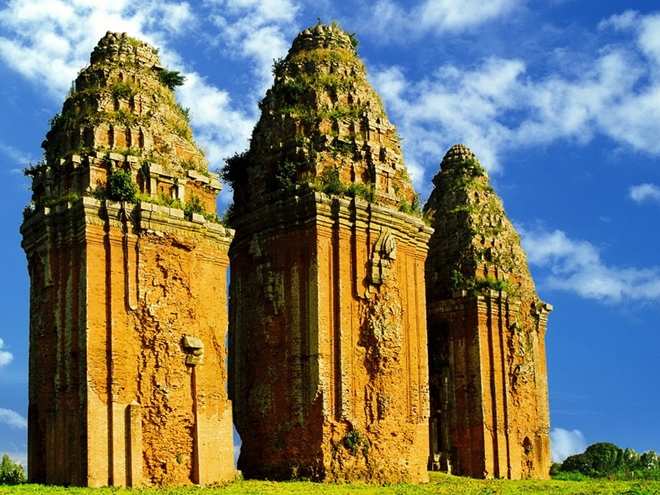 |
From Quy Nhon city, travel within a radius of 40 km, tourists can visit most of thevCham towers here. Thirteen towers are arranged in 8 groups, Cham Towers in Binh Dinh Province have a unique architectural heritage.
The first tower in the journey to explore is the Twin towers built during the late 12th century, one big and one small, standing close together as couples gravitate. About 300 m from the 1A roadis Banh It towers complex. The layout of the towers here is quite unique and typical of Cham architecture; standing at the door of each tower you can observe the other tower.
Canh Tien Tower located alone 500 meters from National Highway 1A, has Binh Dinh style with spears sharp arch, and is simple, robust, with less decorative tower walls.
Located on a hill of Tay Binh commune, Tay Son district, Quy Nhon, Duong Long Cham Tower is a complex of three towers.
This is a historical relic that represents the most prosperous time of Cham Pa civilization in the 12th Century. It is one of the most beautiful Cham Pa Towers in central Vietnam.
Although they have been damaged many times in the past by treasure hunters and the local people, the towers still radiate an impressive beauty.
Duong Long Towers consist of three spires: the central one is 24m high, and the two towers on either side of it are 22m. The attraction of the towers is not only the outstanding height compared to the other Cham Pa buildings in Binh Dinh, but also the carved stone designs which weave throughout the complex.
Duong Long Towers were created by bricks and the corners were connected by stones with huge engraved plates that show sacred Cham Pa animals such as Garuda, Elephant and Eagle.
The main door faces east towards the Sun, and was built using 1.5m tall stones. The upper half of the tower was built by similarly large stones that overlap each other precisely, displaying the ingenuity and skill of the Cham Pa people.
The wall is decorated with the carved images of monks in high-top hats, dancing and singing. The top of the towers are crowned by lotus petals rising to the sky.
Visitor can discover some other towers such as Binh Lam Tower, Thu Thien Tower; Phu Loc Tower…The unique decoration of Cham Towers makes you feel like you are lost in the mystical ancient world of the Cham.
This is a historical relic that represents the most prosperous time of Cham Pa civilization in the 12th Century. It is one of the most beautiful Cham Pa Towers in central Vietnam.
Although they have been damaged many times in the past by treasure hunters and the local people, the towers still radiate an impressive beauty.
Duong Long Towers consist of three spires: the central one is 24m high, and the two towers on either side of it are 22m. The attraction of the towers is not only the outstanding height compared to the other Cham Pa buildings in Binh Dinh, but also the carved stone designs which weave throughout the complex.
Duong Long Towers were created by bricks and the corners were connected by stones with huge engraved plates that show sacred Cham Pa animals such as Garuda, Elephant and Eagle. The main door faces east towards the Sun, and was built using 1.5m tall stones.
The upper half of the tower was built with similarly large stones that overlap each other precisely, displaying the ingenuity and skill of the Cham Pa people. The wall is decorated with the carved images of monks in high-top hats, dancing and singing. The top of the towers are crowned by lotus petals rising to the sky.
Swallow Island
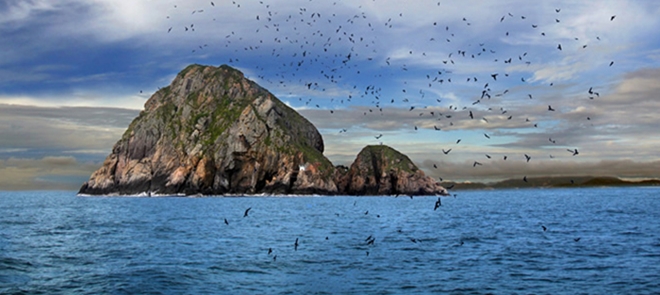 |
Phuong Mai Island, which local people call Swallow Island (Yen Island), is located near Quy Nhon city, eastern Binh Dinh. It contains a mountain which looks like a dinosaur standing imposingly to defend strong winds and big waves.
Not only creating a wonderful aquarelle picture, the nature also awards people here with a treasure that is swallow – an extremely specious specialty wanted worldwide.
Swallow Island has an interesting, fascinating landscape thanks to ancient caves with hundreds of meters of high rock canopies, high and dangerous cave where swallows to build their nests.
Come to Swallow Island in spring, people will have a chance to see flocks of swallow flyingin the sky and chirping to call each other.
According to document of researchers, there are two main types of swallows in the Quy Nhon Swallow Island: yen co and yen sao. Yen co is bigger than yen sao, and they build their nests by using grass from top of mountain. Yen sao has avsmall body. They find food by flying as well as catching food in the sea; they can fly continuously for ten hours without stopping.
The nests of yen sao are not made of grass but of their saliva; each day they generate a little saliva, pull this to make threads to form nests. After a period, the nests are dry. They looklike ears sticking to cave ceiling and cliffs. When finishing the nests to fit the body, swallows start to breed.
Visit Swallow Island, besides contemplating the charming scenery outside, tourists can also go further inside the cave to enjoy the majestic beauty created by nature.
On the cliffs, interfering with water drops, there are tiny white points; the scene looks like a summer night sky having a plenty of stars. The swallow nests are arranged tightly, making a long string; somewhere the swallows spread their wings and blow their breath to warm their children; sometimes there is a voice of young birds calling mothers to feed.
The sound of waves, water dropping, wings flapping, swallows' voices… all mix together, making a strange rhythm.
Ghenh Rang
 |
Ghenh Rang is one of the most attractive destinations in Binh Dinh. It has magnificent natural scenery with mountains, forests, beaches and islands that can’t be seen in such a combination anywhere else.
At the south west are high mountains that reach the ocean, and from these mounts you can survey great distances of natural beauty: the Lion’s Head rock that leaps to reach the sea; the silent Waiting Statue; the Lying Elephant and Bear rocks that guard the beaches, and Chong Islet which seems to be light, but is stable in the heavy rain.
On the north east of Ghenh Rang is a blue ocean that covers the white sandbanks with cool water and a stunning view. This is one of the most beautiful beaches in Binh Dinh, and has greeted bathers in search of relaxation for many years.
In 1927, Bao Dai, the last king of Vietnam, built a villa where his family could come and relax. He reserved the whole beach for just Queen Nam Phuong, his most beloved wife. It is because of this that the beach is now called Queen Beach.
From the view on the top of the mountain, the beach looks like a large turquoise field filled with jade and granite eggs. And so, apart from “Queen’s Beach”, the local people also call it “Egg Stone” beach.
From the Queen Beach to the garden of rock “animals” and strange rock eggs are many modest garden houses nestled amid the plants and trees. The path to Ghenh Rang passes by the modest grave of poet Han Mac Tu.
Looking at the dazzlingly yellow chrysanthemums, visitors may be full of pity for the miserable life of this talented poet. The grave all year round is drenched in sunlight, clouds, winds, moonlight and the murmurs of the sea.
Bau Da Village
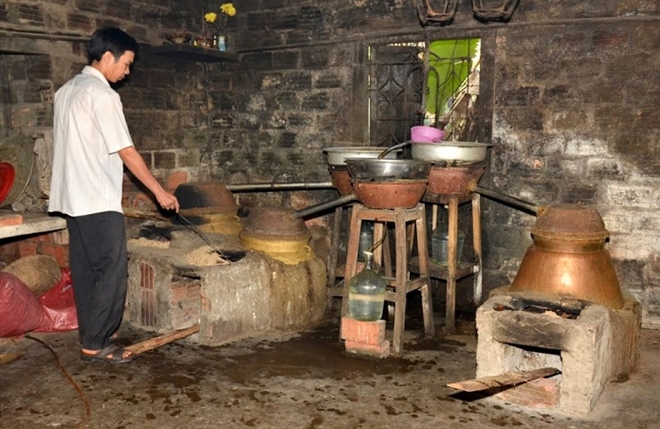 |
It is said that Bau Da liquorcauses sensations of fire and ice. As a matter of fact, get a drop on your skin, and you will get a chilly feeling.
Locals say that northern and southern tourists treated to Bau Da have said it is better than Johnny Walker brandy.
It is made of newly-harvested rice grains and special water, which make it transparent, and then distilled over a straw and husk-fired heat.
However, the most attractive aspect of Bau Da liquor is that intimate friends prefer to sit cross-legged on the floor on a moonlit night to enjoy it while reciting stories.
Cu Lao Xanh (Green Islet)
Cu Lao Xanh means Green Islet, located in Nhon Chau commune, Quy Nhon city. It is considered a charming pearl on the sea, with amazing green sea water.
The island has a total area of over 450 ha, in which mountains and forest cover 75 percent of the area. Despite some difficulties, Cu Lao Xanh has many advantages for growth thanks to sea resources and potential for sea economic development and eco-tourism.
The residents on Cu Lao Xanh are scattered, mainly elders and kids, so you will have chance to experience the life of a deserted island. You can join fishing with local people and set up a BBQ party on the beach.
There is a lighthouse on the island, which was built in 1890. It is one of the 30 largest lighthouses in Vietnam.
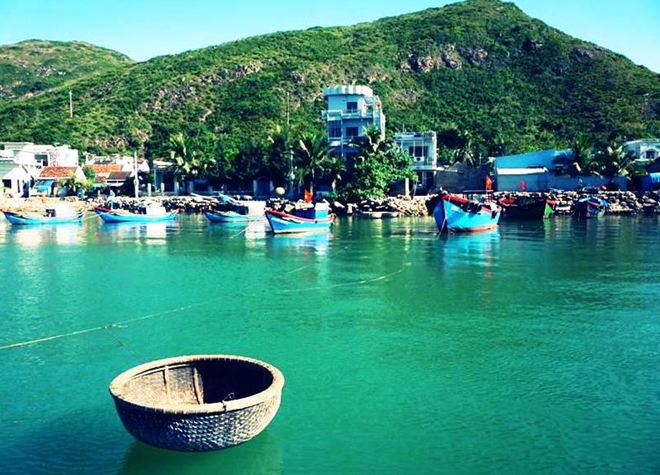 |

